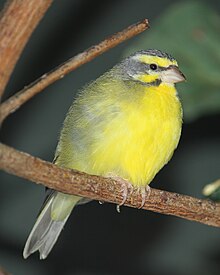Yellow-fronted canary
| Yellow-fronted canary | |
|---|---|
 |
|
| Scientific classification | |
| Kingdom: | Animalia |
| Phylum: | Chordata |
| Class: | Aves |
| Order: | Passeriformes |
| Family: | Fringillidae |
| Subfamily: | Carduelinae |
| Genus: |
Crithagra Swainson, 1827 |
| Species: | C. mozambicus |
| Binomial name | |
|
Crithagra mozambicus (Müller, 1776) |
|
| Synonyms | |
|
Serinus mozambicus |
|
Serinus mozambicus
The yellow-fronted canary (Crithagra mozambicus), also called Yellow-eyed Canary, is a small passerine bird in the finch family. It is known elsewhere and in aviculture as the green singing finch.
The yellow-fronted canary was formerly placed in the genus Serinus but phylogenetic analysis using and nuclear DNA sequences found that the genus was polyphyletic. The genus was therefore split and a number of species including the yellow-fronted canary were moved to the resurrected genus Crithagra Swainson 1827.
This bird is a resident breeder in Africa south of the Sahara Desert. Its habitat is open woodland and cultivation. It nests in trees, laying 3–4 eggs in a compact cup nest.
The yellow-fronted canary is 11–13 cm in length. The adult male has a green back and brown wings and tail. The underparts and rump are yellow, and the head is yellow with a grey crown and nape, and black malar stripe. The female is similar, but with a weaker head pattern and duller underparts. Juveniles are greyer than the female, especially on the head.
The yellow-fronted canary is a common, gregarious seedeater. Its song is a warbled zee-zeree-chereeo.
...
Wikipedia

